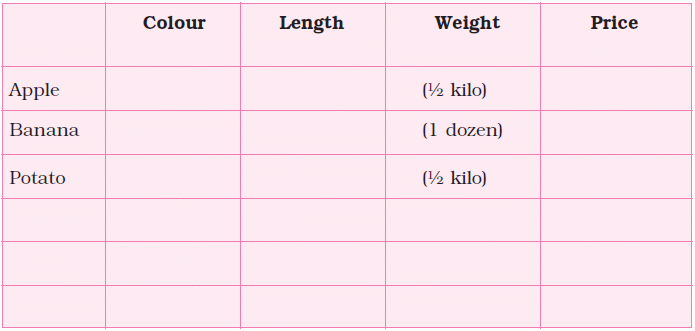NCERT Solutions for Class 4 EVS Chapter 15 - From Market to Home
| Table of contents |

|
| Page No 120 |

|
| Page No 122 |

|
| Page No 123 |

|
| Page No 124 |

|
| Page No 125 |

|
Page No 120
Q1: Does anyone in your house have to get up very early? What time does he or she get up? Why do they need to get up so early?
Ans: My elder brother gets up very early. He gets up at 5.00 am. He gets up to prepare for his studies
Disclaimer: The purpose of this section is to make students interact actively with their family members. It is strongly recommended that students prepare the answer on their own.
Page No 122
Let us Talk
Q1: Babuji sells the previous day’s vegetables first. Why do you think he does this?
Ans: Babuji sells the previous day’s vegetables first as their chances of getting spoilt are higher, especially during the summers. If the vegetables get spoilt before they are sold, vendors like Babuji would bear losses.
Q2: Have you seen dried or spoilt vegetables? Where?
Ans: Yes, dried and spoilt vegetables are often seen in the market, especially in the late evening hours.
Q3: How did you know that the vegetables were spoilt?
Ans: The following observations indicate that the vegetable were spoilt:
(i) Wrinkled appearance of the vegetables
(ii) Growth of moulds (a type of fungus) on the vegetables
(iii) Bad odour from the vegetables
Q4: Chhotu is helping his family. What do you think Chhotu has learnt from it?
Ans: Chhotu has learnt the art of helping others. He also learnt what teamwork is.
Q5: How do you help the elders in your family?
Ans: I help the elders in my family by providing support when they are walking and picking up things which are heavy or distant to them by handing these things to them.
Q6: Look at the clocks given below. Write what you do, and what Vaishali does, at the time which the clocks are showing 

Ans:
| Name | 3 o' clock Morning | 6 o' clock Morning | 10 o' clock Night |
| Vaishali | Takes out vegetables | Putting vegetables in bag | sleeps |
| Me | Sleep | Prepare Lesson | Going to bed |
Q7: From where do you get vegetables for your home? Who brings the vegetables?
Ans: We get vegetables from market. Usually my mom and I bring vegetables from market.
Page No 123
Some fun with Vegetables
The next time when you get okra (Bhindi) at home, look at them carefully. Are all of them the same size?
Ans: No, all of them are not of the same size.
(a) Find the longest and the shortest one. Measure them.
Ans: The longest lady’s finger was 5 inches, and the shortest one was 2.5 inches.
(b) Do all the okra (Bhindi) have the same thickness and colour? Cut two okra (Bhindi) lengthwise. Do both of them have the same number of seeds? Draw them in your notebook.
Ans: All of them have different thicknesses but are of the same colour. No, they do not have the same number of seeds.
(c) Seema’s mother has brought some fruits and vegetables from the market. Can you find them in this picture? Colour them and write their names alongside.
 Ans: I can find tomato, carrot, potato, spinach, brinjal, pumpkin and lady’s finger.
Ans: I can find tomato, carrot, potato, spinach, brinjal, pumpkin and lady’s finger.
Page No 124
Q1: Given here is a list of vegetables and fruits. Which of these will spoil earlier, and which will stay for some days? Write the names in the correct column. You can add more names in the list.
| Spinach | Potato | Banana | Tomato | Pear |
| Chikoo | Pineapple | Gourd | Onion | Cabbage |
| Cucumber | Grapes | Ginger |

Some of these fruits and vegetables are smooth to touch while some are rough. From the list above, put the names in the correct column
Ans:
| Fruit and vegetables that spoil quickly | Fruit and vegetables that can stay for some days |
| Spinach | Potato |
| Banana | Onion |
| Tomato | Ginger |
| Cabbage | Cucumber |
| Grapes | Pineapple |
| Chikoo | Gourd |
| Strawberry | Radish |
| Cherry | Carrot |
| Pear |
| Smooth | Rough |
| Gourd | Potato |
| Tomato | Pineapple |
| Spinach | Banana |
| Onion | Cucumber |
| Cabbage | Pear |
| Grape | Ginger |
| Chikoo |
Page No 125
Q1: Which vegetable do you find the heaviest to carry? Write its name and draw its picture in your notebook.
Ans: Pumpkin
Q2: Which is the lightest fruit or vegetable that you have eaten? Write its name and draw the picture in your notebook.
Ans: Grapes
Q3: Write names of three vegetables which do not have seeds.
Ans: Carrot, potato and turnip are vegetables that do not have seeds.
Q4: Fill in the table given below. You can add three more names and fill in the table.  Ans:
Ans: 
Q5: Talk with a vegetable-seller in your area. Ask the following questions and make a brief report in the notebook.
(i) What is his or her name?
Ans: Raju
(ii) How many people are there in his or her house? How many children are there at home?
Ans: There are four people in his house. He has two children
(iii) What are the names of the children? How old are they?
Ans: Ajay - 15, Neha - 12
(iv) Who all help in the work of selling vegetables?
Ans: His wife, and son
(v) Who all stay with the vegetable cart or sit in the shop?
Ans: He, his wife, his father and elder son
(vi) What vegetables do they sell?
Ans: All types of vegetables
(vii) What time do they start work?
Ans: They start their work by 4:30 o’clock early in the morning
(viii) For how many hours in a day do they work?
Ans: They work for 15 hours
(ix) Ask them about any three vegetables that they sell.
| Vegetable 1 | Vegetable 2 | Vegetable 3 | |
| Name of the vegetable | |||
| The price of the vegetable | |||
| Where does it come from? | |||
| How much of the vegetable do they buy atone time? | |||
| In which months does this vegetable usually come? |
Ans:
Vegetable 1 | Vegetable 2 | Vegetable 3 | |
Name of the vegetable | Patato | Onion | Tomato |
The price of the vegetable | Rs. 10/- per kg. | Rs. 20/- Per kg. | Rs. 15/- Per kg |
Where does it come from? | Sabzi Mandi | Sabzi Mandi | Sabzi Mandi |
How much of the vegetable do they buy at one time? | 75 kg | 75 kg | 40 kg |
In which months does this vegetable usually come? | All | All | Winter |
|
49 videos|217 docs|54 tests
|
FAQs on NCERT Solutions for Class 4 EVS Chapter 15 - From Market to Home
| 1. What is the process of how products move from the market to our homes? |  |
| 2. What role do middlemen play in the market-to-home process? |  |
| 3. How do consumers influence the market? |  |
| 4. What are some challenges faced in the market-to-home supply chain? |  |
| 5. How has technology changed the market-to-home process? |  |















